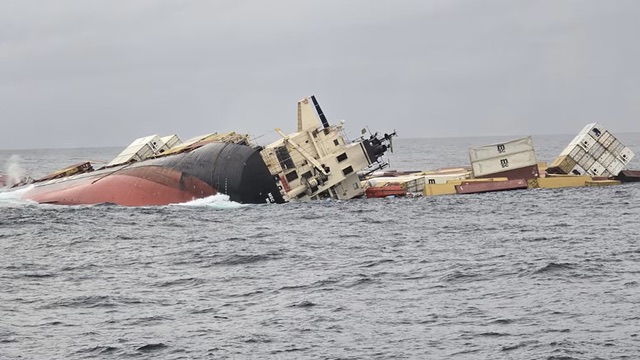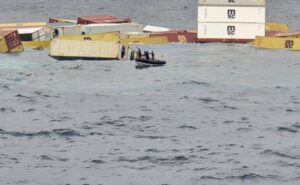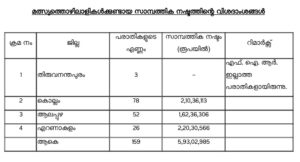Laboratory analyses have detected petroleum-linked compounds such as naphthalene, fluorene and anthracene, along with toxic metals including nickel, lead and vanadium in both water and sediments.
Published Sep 30, 2025 | 9:00 AM ⚊ Updated Sep 30, 2025 | 9:00 AM

The MSC Elsa 3 sank on the morning of 25 May.
Synopsis: Four months after the container ship MSC Elsa 3 sank off the Kerala coast, the ecological and economic impact of the wreck is yet to be resolved. Conflicting preliminary reports from scientific institutions, together with government claims of limited contamination and minimal effect on fish populations, contrast with evidence of persistent oil leaks, chemical pollution, and ecological disruption. Meanwhile, the legal dispute over compensation continues, with the state pursuing the shipping company under the “polluter pays” principle, leaving affected communities out in the cold.
It has been four months since the container ship MSC Elsa 3 sank off the Kerala coast.
The Fisheries Department has offered no clarity on compensation or the long-term impact, even as multiple reports suggest the wreck has left behind more than plastic nurdles and cotton bales and may have contaminated the sea with toxic materials.
Laboratory analyses have detected petroleum-linked compounds such as naphthalene, fluorene and anthracene, along with toxic metals including nickel, lead and vanadium in both water and sediments.
Another study has warned of a 70 per cent shrinkage in mackerel eggs, likely caused by quicklime spillage from containers. Between May and June alone, the fisheries sector is estimated to have suffered losses of ₹420 crore.
For Kerala’s fisherfolk, who have been kept in the dark, the wrecks are no longer seen as isolated accidents but as harbingers of an ecological catastrophe.
A scientific probe by the Centre for Marine Living Resources and Ecology (CMLRE), under the Ministry of Earth Sciences, has confirmed that the sinking of MSC Elsa 3 on 25 May caused major ecological damage in the south-eastern Arabian Sea.

Hazardous containers from the sinking MSC Elsa 3 were afloat 14.6 nautical miles off the Thottappally coast on 24 May.
A research cruise aboard FORV Sagar Sampada, conducted between 2 and 12 June, surveyed 23 sites between Kochi and Kanyakumari, with intensive sampling near the wreck.
The investigation found that water quality, plankton, benthic organisms, fish eggs, larvae and higher marine life were all adversely affected. The persistence of oil slicks days after the incident, despite strong currents and turbulence, indicated ongoing leakage from the sunken vessel.
Chemical analysis detected toxic polyaromatic hydrocarbons (PAHs) such as naphthalene, fluorene, anthracene, phenanthrene, fluoranthene and pyrene. Elevated naphthalene levels, a marker of human-induced pollution, pointed to leaking fuel compartments.
Sediment and water samples also showed high concentrations of petroleum-linked trace metals, including nickel, lead, copper and vanadium.
The findings confirmed the wreck as a continuing source of hydrocarbon and heavy-metal pollution, prompting urgent calls to seal its fuel tanks and implement long-term monitoring to protect marine ecosystems and fisheries resources.
Immediately after the sinking of MSC Elsa 3, the state government directed three scientific institutions—Kerala University of Fisheries and Ocean Studies (KUFOS), ICAR-Central Marine Fisheries Research Institute (CMFRI), and ICAR-Central Institute of Fisheries Technology (CIFT)—to submit preliminary reports.
Together, these reports paint a picture that is far from conclusive, oscillating between reassurance, alarm, and calls for further investigation.
The most concerning findings have come from KUFOS researchers. Their interim report, submitted on 23 June, highlights deformities in fish eggs—particularly Indian mackerel—collected off Kollam. At the 10-metre sampling station, nearly 70 per cent of the eggs were shrunk and deformed; at 30 metres, around 10 per cent showed similar abnormalities.
Since mackerel eggs hatch within four to six days, researchers suggest a direct link between the deformities and the arrival of containers carrying plastic pellets and possibly quicklime (calcium oxide) on Kollam shores around 25–26 May. Quicklime can sharply increase seawater alkalinity and pH, leading to osmotic imbalances that disrupt egg development.
The KUFOS report also highlights the economic impact, estimating losses for the fisheries sector at ₹420 crore due to a 20-nautical-mile fishing ban and falling market prices. The estimate is based on landing data from May and June 2024 at four major centres—Ernakulam, Alappuzha, Kollam, and Thiruvananthapuram.
In contrast, CMFRI’s preliminary report in June offered a more reassuring view. The institute reported no visible oil slicks at its monitoring stations and no large-scale chemical contamination in nearshore waters during the study period.
However, while no microplastics or cotton strands were detected in the gills or guts of sampled fish, the report acknowledged limitations: the fishing ban and rough seas meant fewer specimens were available for analysis. Importantly, CMFRI noted the “significant concern” of plastic nurdles, disintegrated cotton bales, and other debris from the wreck, which could have long-term ecological implications.
Meanwhile, the earliest interim analysis, conducted by CIFT on samples collected by Matsyafed from Ernakulam, Alappuzha, and Kollam on 29 May, reported that:
Jackson Pollayil of the Kerala Swathanthra Matsya Thozhilali Federation told South First that the government’s narrative around the MSC Elsa 3 shipwreck was riddled with half-truths and outdated data.
“The assessments were rushed and obsolete; the real impact could be far graver than what’s being presented. The state keeps saying fish is safe to consume, but that conclusion was drawn from a report dated 29 May—barely five days after the incident. How can anyone surmise the long-term consequences from such a hasty study?” he asked.
Fisherfolk were also never informed about the reported damage to mackerel eggs, raising fears of unseen ecological fallout.
Pollayil alleged that the government appeared to be hiding facts. “Even today, we don’t know how the wreck happened or the current status of operations. The state claims it has sued MSC, but only time will tell if its arguments will hold the company accountable for this disaster that threatens Kerala’s coast and beyond,” he added.
It has also come to light that the state stopped updating situation reports on salvage operations of MSC Elsa 3 after 8 August, despite a Kerala High Court directive to keep the public informed.
Fisherfolk and the state government remain at odds over compensation for losses following the shipwreck.
For the fishing community, immediate relief is the pressing demand. However, the state government insists that recovery will follow the “polluter pays” principle.

Data from the Fisheries Department specify the number of complaints and financial losses due to shipwrecks, but do not specify the timeframe.
Fisheries Minister Saji Cheriyan explained that the Environment Department has already filed an Admiralty Suit in the Kerala High Court, seeking ₹9,531.11 crore from the shipping company responsible. The claim covers environmental damage, restoration, clean-up operations, other expenses, and compensation for affected fishing communities.
As part of this legal action, the High Court, on 7 July 2025, ordered the arrest of the cargo ship MSC AKITETA II, owned by the same company, at Vizhinjam International Seaport, Thiruvananthapuram. The company contested the move, but on 25 September 2025, the court clarified that the state government had the authority to pursue the suit.
The minister emphasised that the state is taking “vigorous steps” to ensure recovery and compensation for fisherfolk.
So far, 159 complaints have been filed across Thiruvananthapuram, Kollam, Alappuzha, and Ernakulam districts, with total financial losses pegged at ₹5.93 crore. Kollam recorded the highest number of complaints (78), while Ernakulam reported the highest financial loss (₹2.20 crore). Thiruvananthapuram, despite three complaints, had none backed by FIRs.
The minister added that losses from Kollam, Alappuzha, and Ernakulam have been calculated and handed over to the District Collectors, who chair the respective District Disaster Management Authorities. No compensation has been disbursed yet, he stated in the Assembly.
Meanwhile, Jackson Pollayil, representing fisherfolk, criticised the government’s rigid stance. He argued that the state should first disburse compensation directly to affected families and recover the money from the polluter later, rather than making victims wait indefinitely.
He also questioned the accuracy of complaint figures and compensation estimates, pointing out that the government had not clarified the timeframe over which complaints were received.
The true measure of this disaster, he suggested, will lie not just in assessed damage but in how quickly relief, accountability, and ecological repair are implemented.
(Edited by Dese Gowda)
